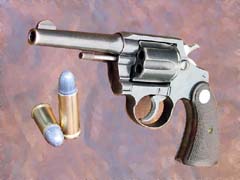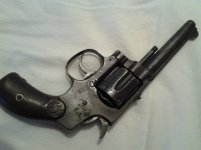The Model 1896 cylinder is marked over the chambers 1) SMITH/&/WESSON in three lines, 2) SPRINGFIELD/MASS. in two lines, 3) U.S.A./PATENTED in two lines, 4) JULY 1, 84/APRIL 9, 89 in two lines, 5) MARCH 27, 94/MAY 29, 94 in two lines, and 6) MAY 21, 95/JULY 15, 95 in two lines. All the lettering is in a back slanting font that I have never seen on any other S&W. Other than the serial number on the butt and the S&W logo on the right side, there are no other markings. The cylinder stop is in the topstrap and is a slightly modified version of the ones used on the old tip-up revolvers.
Jim



